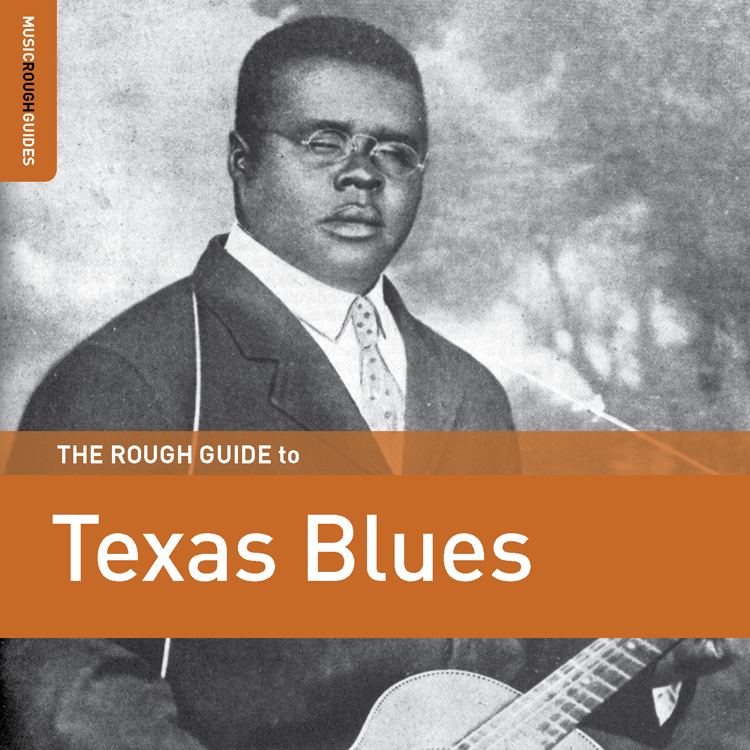The compilation The Rough Guide To Texas Blues (World Music Network/Rough Guides) will be available January 28, 2022. The collection includes the diverse early blues genres of the 20th century.
Texas is one of the musical melting pots of the United States, and even though Mississippi receives most of the credit for creating the blues, Texas is where many of the earliest blues pioneers lived and performed. The Texas blues was essentially less raw and rudimentary with guitarists typically incorporating more sophisticated and varied guitar accompaniments from verse to verse.
Blind Lemon Jefferson recorded a stunning one hundred or so sides in just three short years between 1926 and 1929. He established himself as one of the very first successful blues recording artists before his premature death at the age of just 36. Like many songsters of his time, Jefferson was renowned for his versatility and wide-ranging repertoire from rags and spirituals to blues and other popular songs of the day. His monumental musical influence had a huge effect on all who crossed his path including Leadbelly, who pays his respects in the featured ‘My Friend Blind Lemon’ and Aaron Thibeaux Walker (T-Bone Walker), a family friend to whom Jefferson is thought to have passed on his guitar knowledge in exchange for Walker’s services as a guide.
Dallas was an important hub for the Texas blues scene during the 1920s and among its most popular acts was the Dallas String Band. The band’s song set was drawn largely from minstrel, vaudeville, and ragtime traditions, and was primarily made up of vaudevillian songster Coley Jones on mandolin, bassist Marco Washington, and guitarist Sam Harris, with a few transient members joining in occasionally including even Blind Lemon Jefferson. Their version of ‘Dallas Rag’ has endured as one of the band’s most loved tunes and is popular to this day amongst guitar pickers. The band’s leader, Coley Jones, was a prominent figure in the Afro-American music scene of Dallas.
Henry Thomas’ estimated birthdate of 1874 predates that of Blind Lemon Jefferson by two decades and gives the listener an idea of what rural black music sounded like before the turn of the twentieth century. He was 53 years old during his first recording session in 1927 by which point much of his music was already a representation of a bygone era. His songs have been recreated and much covered by artists including Bob Dylan, The Lovin’ Spoonful, and the Grateful Dead who covered the classic opener ‘Don’t Ease Me In’ for their debut single in 1966.
The powerful vocals of both Texas Alexander and Bessie Tucker provide another important insight into the pre-blues tradition as they express their lyrics in the style of the old southern field hands in their respective ‘Bell Cow Blues’ and ‘Got Cut All To Pieces’, thus helping to preserve the musical traditions of work songs and field hollers.
Likewise distinctive was the slide guitar artistry of blues pioneers who performed in and around the Texas region such as Black Ace, Oscar Woods and Ramblin’ Thomas whose playing represents another key aspect of the Texas blues.
Many of these featured musicians were connected in some way, and the blues diva Victoria Spivey was another who had performed with Blind Lemon Jefferson. She was one of the most influential blues women of her era. She wrote songs, sang them with heartfelt passion and accompanied herself on piano, an instrument whose importance and contribution shouldn’t be overlooked in blues history from the region. In fact, no other southern state produced as many local pianists as Texas, including Texas Bill Day and the more well-known Whistlin’ Alex Moore whose ‘West Texas Woman’ concludes this collection of tracks grounded in the traditions of Texas.
Buy The Rough Guide To Texas Blues



Emocionante.Gracias.Todo está en esta música.